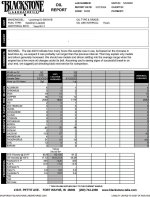Yesterday I picked up my resealed Hartzell constant speed prop from the prop shop. 100 hours from new and it had to be resealed due to slinging grease.
When I removed the prop it was shocking to see the grey greasy oil in the prop hub and crank. The prop shop said the hub was packed with a grey clay like substance. This somehow caused the prop to start slinging grease. I need to figure out what's going on before I reinstall the prop.
My suspicion is the reusable S15 oil filter MAY be the culprit. Why? Well the first 25 hours of the engines life (I0-360-M1B) the factory Champion oil filter was in service. Then I installed the S15 reusable filter, 25 hours later, changed the mineral oil out for Phillips XC 20W50 and Camguard. The sample results that came back from Blackstone were stellar. The next oil change happened at 50 hours (100 hours total time) and the sample results were concerning. Some of the results risen significantly. At this time the prop was removed for resealing and the ugly grey oil was noticed in the crank and prop hub.
QUESTION:
My tentative plan is to remove the S15 filter and install a Champion filter, run for 25 hours then change the oil and pull the prop for inspection.
When I removed the prop it was shocking to see the grey greasy oil in the prop hub and crank. The prop shop said the hub was packed with a grey clay like substance. This somehow caused the prop to start slinging grease. I need to figure out what's going on before I reinstall the prop.
My suspicion is the reusable S15 oil filter MAY be the culprit. Why? Well the first 25 hours of the engines life (I0-360-M1B) the factory Champion oil filter was in service. Then I installed the S15 reusable filter, 25 hours later, changed the mineral oil out for Phillips XC 20W50 and Camguard. The sample results that came back from Blackstone were stellar. The next oil change happened at 50 hours (100 hours total time) and the sample results were concerning. Some of the results risen significantly. At this time the prop was removed for resealing and the ugly grey oil was noticed in the crank and prop hub.
QUESTION:
- Any thoughts on the grey sludge and what produces it?
- Besides cleaning out the visible area of the crank, is there anything I should do to ensure the grey stuff isn't in the governor?
- Could this have been caused by not getting all the Lycoming preservation oil out before the initial engine run?
My tentative plan is to remove the S15 filter and install a Champion filter, run for 25 hours then change the oil and pull the prop for inspection.





